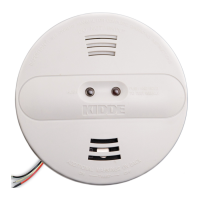in place to make certain that the red wire cannot contact any
metal parts or the electrical box.
• When alarms are interconnected, all interconnected units must
be powered from a single circuit.
• A maximum of 24 Kidde/Lifesaver devices may be intercon-
nected in a multiple station arrangement. The interconnect sys-
tem should not exceed the NFPA interconnect limit of 12 smoke
alarms and/or 18 alarms total (smoke, heat, carbon monoxide,
etc.). With 18 alarms interconnected, it is still possible to inter-
connect up to a total of 6 remote signaling devices and/or relay
modules.
• When mixing models which have battery backup (Kidde mod-
els: 1275, 1276, 1285, 1296, i12040, i12060, i12080, i4618,
PE120, PI2000, PI2010, RF-SM-ACDC, KN-SM-FM-I, KN-COSM-
IB, HD135F, KN-COB-IC, KN-COP-IC, KN-COPF-I and FireX
models: AD, ADC, FADC) with models without battery backup,
(Kidde models: 1235, i12020, KN-COSM-I, 120X, SM120X,
CO120X, SL177) be advised that the models without battery
backup will not respond during an AC power failure.
• The maximum wire run distance between the first and last unit
in an interconnected system is 1000 feet.
• Figure 4 illustrates interconnection wiring. Improper connection
will result in damage to the alarm, failure to operate, or a shock
hazard.
• Make certain alarms are wired to a continuous (non-switched)
power line. NOTE: Use standard UL listed household wire (as
required by local codes) available at all electrical supply stores
and most hardware stores.
FIGURE 4 INTERCONNECT WIRING DIAGRAM
WIRES ON ALARM HARNESS CONNECTED TO
1475-7205-00(820-0905-EN)_R1.indd 61475-7205-00(820-0905-EN)_R1.indd 6 2009.12.9 10:07:37 AM2009.12.9 10:07:37 AM

